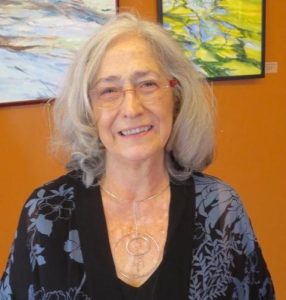Carmela Azzaro

My personal preference is working outside, where I can not only “see” what I am “looking” at, but the tactile sensations of my surroundings energizes me.


Q&A with Carmela Azzaro
How would you describe your background?
I have an Art Education degree from Indiana University of Pennsylvania. During my career as an art teacher, I always continued to draw and paint. When I retired, I had the privilege of studying with Keene State professors, John Roberts and Peter Roos. And, of course the incredible support of Sam Azzaro. These three professors have been both critics and mentors and have helped me to grow as an artist.
When did you know you wanted to be an artist?
Like so many artists, I knew I wanted to make Art my life’s work from a very early age. I remember pointing to a sign, as my dad was driving a 1950 black Chevrolet, past a sign that said ART telling him “that is what I want to do when I grow up.”
What would surprise people to learn about you?
I don’t really think I am very creative.
I can draw just about anything, but I don’t feel I am very inventive.
What achievements in art are you proudest of?
Being a recipient of The Ruth & James Ewing Arts Award is one of my proudest moments. Participating in the Selections Invitational Exhibition, Library Arts Center, Newport, NH. Being included twice in the Thorne Sagendorph Biennial Regional Jurors’ Choice Competition. Invited to have a Solo Exhibition at the Dub Hub in Dublin, NH. Lastly, the “Best in Show” Award at Stonewall Farm’s 10th Annual Exhibition gave me the boost in confidence that I needed.
How would you describe your art process?
My personal preference is working outside, where I can not only “see” what I am “looking” at, but the tactile sensations of my surroundings energizes me. I draw, use watercolor, and add notes on how the environment is affecting me. I do take photographs, that I use as a guide for color. Usually my compositions are a result of my on-site drawings that I transfer to a canvas in my studio. Back in my studio, my “process” depends on the size of the canvas. For small works, under 24” x 24”, I draw directly on the canvas. For large works, I make my sketches using lines and shapes, enlarged on drafting paper and then transfer the sketch to the canvas. Simplicity and composition are the two principles I work with. Small works demand more attention to detail, large paintings provide me the opportunity to explore the incredible variety of tools available to artists.
What is your usual studio/working day like?
I usually listen to either jazz, classical or old time rock & roll, depending on my painting. My brush often “moves” with the music.
What is the most delightful part of your life outside of work?
What is the most delightful part of your life outside of work?
Cooking and spending time with my husband, family and friends.
